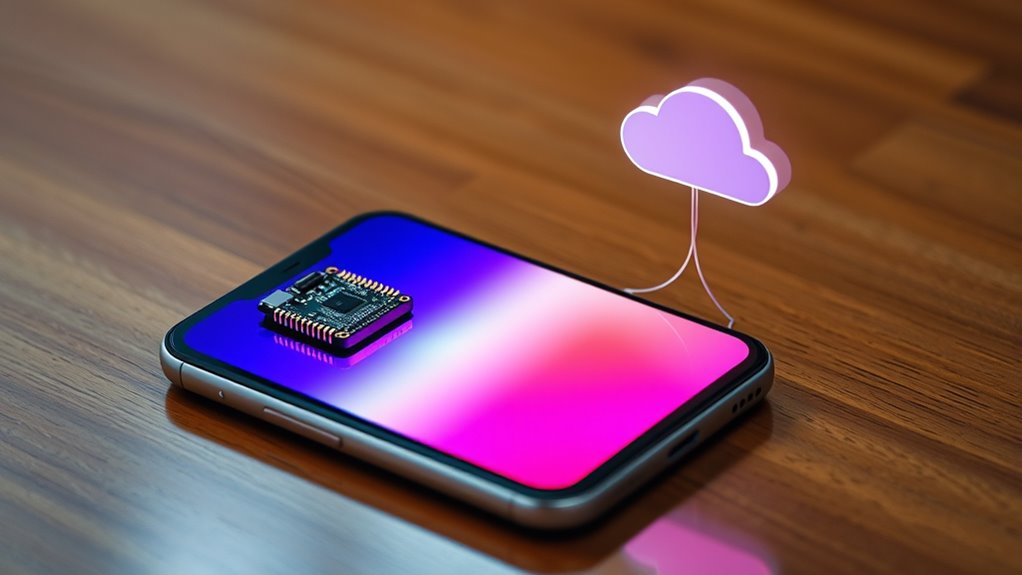On‑Device AI Vs Cloud AI: Differences Explained

On-device AI processes data locally on your device, offering faster responses and better privacy since your sensitive information stays on the device. Cloud AI, on the other hand, relies on remote servers for complex tasks and frequent updates, but it involves transmitting data over the internet, which can raise security concerns. While on-device AI prioritizes speed and privacy, cloud AI provides scalable power and access to advanced models. Continue, and you’ll discover more about how each option suits different needs.
Key Takeaways
- On-device AI processes data locally, offering faster responses and enhanced privacy, while cloud AI relies on remote servers with potential latency.
- Cloud AI provides access to more powerful models and updates, whereas on-device AI depends on limited hardware capabilities.
- On-device AI reduces security risks by keeping sensitive data on the device, unlike cloud AI, which involves transmitting data over the internet.
- Cloud AI supports intensive processing and large datasets, suitable for scalable applications, while on-device AI is ideal for real-time, privacy-sensitive tasks.
- The choice depends on balancing privacy, speed, processing power, and security considerations for specific application needs.

As artificial intelligence continues to advance, you often have to decide between on-device AI and cloud AI for your applications. Each approach offers distinct advantages and challenges, especially when it comes to privacy concerns and data latency. On-device AI processes data directly on your device, such as your smartphone or IoT gadgets, without needing to send information over the internet. This setup can markedly improve privacy because sensitive data stays local, reducing the risk of exposure or misuse. When privacy is a top priority—like handling personal health data or confidential business information—on-device AI provides a more secure solution. You won’t have to worry about your data being stored or mishandled by third parties, giving you greater control over your information.
Data latency plays an essential role in your decision as well. With on-device AI, processing happens instantly because there’s no need to communicate with external servers. This means faster responses, which is indispensable for real-time applications like voice assistants, autonomous vehicles, or augmented reality. When low latency is imperative, relying on local processing ensures that you don’t experience delays caused by network issues or server load. Meanwhile, cloud AI involves sending data to remote servers where complex computations are performed. While this can enable more powerful AI models and access to updated data, it introduces latency that might impact the user experience, especially in situations where rapid responses are necessary.
However, cloud AI has its own set of advantages. It allows you to leverage vast computing resources and continuously updated models without needing to upgrade your device hardware. This scalability makes it suitable for applications that require large datasets or intensive processing power, like big data analytics or machine learning training. Yet, this comes with trade-offs, including concerns about privacy, since your data must travel over the internet and be stored on external servers. Security measures are critical, but the risk of data breaches or unauthorized access remains a concern, especially for sensitive information. Additionally, AI security vulnerabilities such as jailbreaking techniques can sometimes be exploited, highlighting the importance of robust safety measures.
Ultimately, your choice between on-device and cloud AI depends on your specific needs. If privacy and rapid processing are paramount, on-device AI offers clear benefits. Conversely, if your application demands complex computations and access to the latest models, cloud AI might be more appropriate, provided you’re comfortable with potential latency and privacy considerations. Weighing these factors carefully ensures you select the right AI approach to meet your goals while managing risks effectively.
Frequently Asked Questions
How Secure Is Data Processed On-Device Versus in the Cloud?
Your on-device AI keeps data more secure because it uses data encryption and access control directly on your device, reducing exposure. In contrast, cloud AI involves transmitting data over the internet, which can introduce vulnerabilities if not properly protected. With on-device processing, you have more control over your data, minimizing risks of breaches, whereas cloud AI depends on the security measures implemented by service providers.
What Are the Best Use Cases for On-Device AI?
Over 60% of data processing now occurs on devices, making on-device AI ideal for edge applications. You should use it for real-time tasks like voice assistants, personalized experiences, and autonomous vehicles, where quick responses matter. On-device AI enhances privacy and reduces latency, ensuring your device handles sensitive data locally. It’s perfect when instant decisions are needed without relying on cloud connectivity, providing seamless, secure, and personalized user experiences.
How Does Latency Differ Between On-Device and Cloud AI?
On-device AI offers lower latency because processing speed is faster without relying on a network connection. You’ll notice quicker responses, especially in real-time applications, since it doesn’t depend on network dependency. In contrast, cloud AI can experience delays due to network latency, which affects processing speed. This makes on-device AI ideal for scenarios requiring instant results, while cloud AI might be suitable when processing large data sets or updates.
Can On-Device AI Update Itself Automatically?
Yes, on-device AI can update itself automatically, enhancing device autonomy and ensuring it stays current. You might notice these updates happen seamlessly in the background, without interrupting your tasks. Automatic updates improve performance, security, and accuracy, giving you a smarter, more responsive device. With this process, your on-device AI remains fresh and reliable, just like a well-maintained tool that continuously adapts to your needs without manual intervention.
What Are the Cost Implications of On-Device Versus Cloud AI?
You’ll find that on-device AI often has higher upfront costs due to hardware, but it can save you money long-term by reducing ongoing data transfer and cloud service fees. Cloud AI typically involves lower initial expenses but can rack up substantial costs with continuous data processing and storage. When considering your budget, weigh these cost comparisons carefully to choose the option that aligns best with your budget considerations and usage needs.
Conclusion
In the battle between on-device AI and cloud AI, each has its strengths like two sides of the same coin. On-device AI acts instantly, like a lightning bolt, offering privacy and offline capabilities. Meanwhile, cloud AI provides vast power and updates from the internet, like an ocean of knowledge. Understanding these differences helps you choose the right technology for your needs, ensuring you get the best of both worlds without missing a beat.
